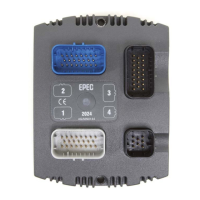Epec CAN Module Family
2024 CONTROL MODULE
8 / 34
07.10.2010
2024G08,G18 / MAN000185
Epec Oy reserves all rights for improvements without prior notice
Epec Oy Postiosoite/Postal address Puhelin/Phone Fax Internet
Tiedekatu 6 PL/P.O.Box 194 +358-(0)20-7608 111 +358-(0)20-7608 110 www.epec.fi
FIN-60320 Seinäjoki FIN-60101 Seinäjoki, Finland
2.1.1 Codesys 2.1
• Flash
• 248 x 16-bit flash saved parameters (Runtime older than 2.15)
• 756 x 16-bit flash saved parameters (Runtime 2.15 or newer)
• CAN buses
• Supported baud rates 20, 50, 100, 125, 250, 500 and 1000 kbit/s.
• CAN1
• CANopen
• CAN2
• User programmable
• J1939
• Pulse inputs
• Maximum pulse input frequency 20 kHz.
• Joint frequency for all pulse inputs. (e.g. four channel in use --> 5 kHz for each channel.)
• Minimum PWM frequency
• 40 Hz for 20 MHz module
• 80 Hz for 40 MHz module
2.1.2 Codesys 2.3
• Flash
• 6200 bytes flash saved parameters.
• 10 separately saved sets.
• Maximum code size 256 kb.
• CAN-buses
• User programmable CAN for all physical CAN-buses
• Supported baud rates 50, 100, 125, 250, 500 and 1000 kbit/s.
• Supported protocols
• CANopen (for all physical buses)
• J1939 (only for one bus in the same module)
• ISOBUS (only for one bus in the same module)
• Possible to add external c-programmed library
• Minimum PWM frequency
• 40 Hz for 20 MHz module
• 80 Hz for 40 MHz module
• Maximum pulse input frequency 40 kHz. Joint frequency for all pulse inputs. (e.g. four
channel in use --> 10 kHz for each channel). Is dependable for the other interrupt load in
module (for example heavy CAN-traffic can reduce maximum frequency).
2.2 CANopen Indexes
CANopen communication features can be installed through software, for example NodeIDs and
CAN rates. For more information refer to programming manuals.

